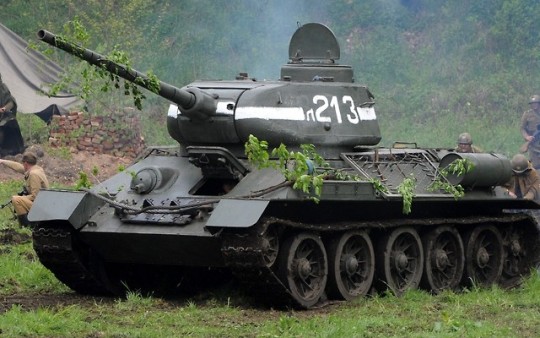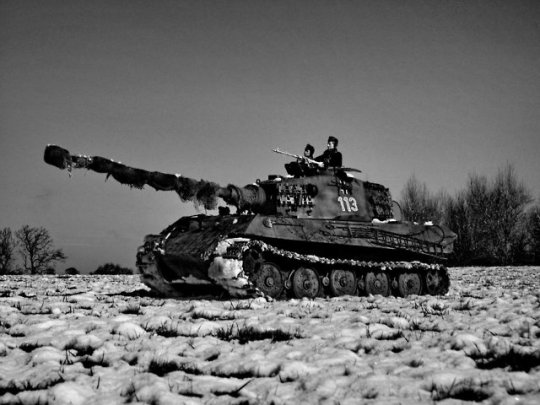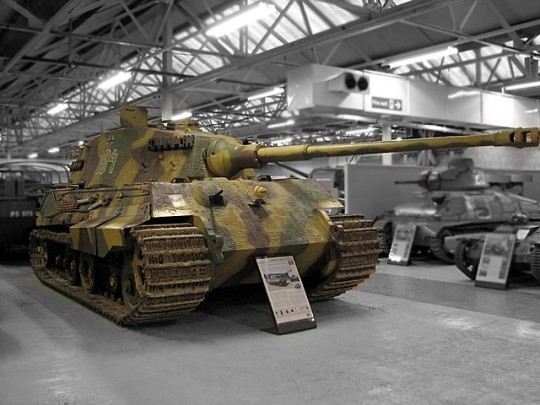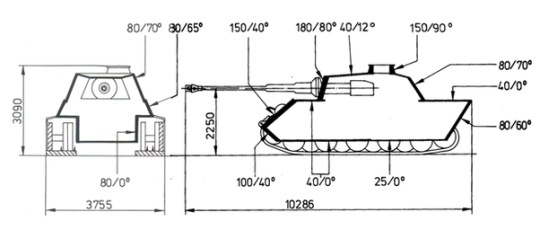Photo


Today’s uh.. ‘tank’ is the Bob Semple Tractor-Conversion Tank. This ‘tank’ is New Zealand’s first (and only) attempt at making an armoured vehicle for the sake of defence. This monstrosity made up of machine-guns, sheetmetal and a tractor hidden underneath was built upon the fear of a Japanese attack on defenceless New Zealand.
-
The tank was named after Bob Semple, the then-acting Minister of Works, who supported the idea of an indigenous New Zealand tank to defend the country from land invasion by Japanese forces. However, he fully knew that the his country’s industry would not be able to attain blueprints from the Western allies, and even if they could, they were simply not built or even equipped to venture into the endeavour of making their own armoured fighting force. So, with the Japanese almost at their doorstep and with little time to produce a tank, they hastily came up with the blueprints to a conversation system that could be bolted on an existing tractor in civilian use.
-
In the original plans for this conversion kit, it was to be mounted with a 37mm cannon along with a whole slew of available machine-guns. The prototypes were also to be built on the Caterpillar D8 bulldozer which was numerous and heavily in use in New Zealand’s public sector. However, on the live prototype, they simply did not have a 37mm gun available to be installed so instead, the turret on the tank housed the same machine-gun that the other firing ports used, the .303 calibre Bren light machine gun. The materials used on the armour were spare metal plates that were bent into corrugated sheets as testing in the army supposedly proved that it made the material more resistant to small-arms fire. Three prototypes were built Railway Workshops in Addington, Christchurch.
-
The Bob Temple tank did not have any spectacular specifications in any stretch of the imagination. It’s armament, six .303 Bren LMG’s may have been great against infantry, but it wouldn’t even scratch Japanese tanks of the time. The worst that these machine-guns could do against other tanks was damage their optics and hope that the crew of the enemy tank retreats. Armour wise.. it wasn’t all that great either. Supposedly, the corrugated metal sheet with metal plating behind it was capable of stopping enemy anti-tank rifle bullets up to 20 mm, but the claim was never tested in the field. During 1941 however, the smallest calibre of cannons that were mounted on Japanese tanks were 37mm cannons with enough punch to pierce through anything that a 20mm cannot. Mobility was.. atrocious at best, and at worst, it might as well have been a static bunker. The 6 cylinder Caterpillar diesel had 127hp and propelled this approximately 18 ton ‘behemoth’ of speeds upwards to 12 km/h. Upwards of 2.5km/h if it resorts to it’s 2:1 gear ratio. This means that a running Japanese soldier would be able to outrun this ‘tank’ even if it were placed in optimal conditions to run its full potential.
-
A final note on the Bob Temple Tank. No matter how horrible this tank is on paper, it was the best that New Zealand had at the time, and it was better off with a makeshift armoured fighting vehicle than having none at all. In Bob Semple’s own words, he describes it as: “That tank was an honest-to-God effort to do something with the material at our disposal when raider were at our back door…instead of sitting down and moaning we felt we ought to do something to manufacture weapons that would help to defend our country and our people.” I respect the effort that the man put for the defence of his country and fellow countrymen, even if the rest of the world laughed at his efforts.
-
Sources:
-“Bob Semple Tank Tractor-Tank Prototype - New Zealand.” Military Weapons, www.militaryfactory.com/armor/detail.asp?armor_id=945.
-“The 'Semple' Tractor Tank.” Tank Encyclopedia, 9 Apr. 2018, www.tanks-encyclopedia.com/ww2/NewZealand/Bob_Semple_Tank.php.
0 notes
Photo




Today’s Panzergespräche will revolve the much controversial T-34/85, the Soviet Union’s main workhorse in the later stages of World War II. With quality being overtaken by quantity, this cheap and easy-to-produce tank became what many would consider the definitive ‘war-winning’ tank.
-
The T-34/85 is essentially just an up-gunned T-34/76. Originally, the T-34/76 was a feared tank in the Eastern Front of World War II. It caused such a panic in fact that the Germans desperately created two tanks to counter these new threats specifically, the Tiger I and the Panther. These heavily armoured German tanks turned the tide against the original T-34/76′s who were simply too thinly armoured and too under-gunned to deal with the new German tanks. However, instead of coming up with a new design, Russian engineers simply opted to up-gun the already proven chassis in order to quickly transition from the 76mm to the capable 85mm.
-
A Russian study during the time found that tanks in the field only lasted 6 months out of combat and a mere 14 hours in combat. Therefore, they concluded that they should convert all major factories to produce large amount of tanks in very little time to combat the invading German force. This meant that many corners were cut and the quality of the tanks plummeted, but the quantity of the tanks that they produced simply became unmatched. A simple turret and gun change was planned instead of a completely new redesign for a new medium tank because the Russians did not want to interfere with its industrial output of T-34′s. They figured that all late-production T-34/76′s and factories will transition quickly and easily fitted with the newly designed turret and gun and it would have minimal impact on production.
-
Originally, the T-34/76 during its prime was the perfect combination of armour, firepower and mobility. Although not superbly thick, the 45mm of frontal armour that was sloped at 60° was enough to deflect and absorb incoming German shells and were only defeated by the strongest Anti-Tank cannons that the Germans had at the time. The 52mm turret mantlet was also adequate for the time. However, when the Germans begin to field Kwk 36′s, Kwk 42′s and long-barrelled Kwk 40′s later in the Eastern Front, they began to punch through Russian armour with ease. The F-34 cannon that they were equipped with were also superb against lighter-armoured Pz. III’s and Pz. IV’s but against Tiger I’s and Panthers, the deficiencies of the 76mm began to show. With the upgrade to the T-34/85 variant, they only addressed firepower and made the turret slightly bigger. The turret mantlet of the T-34/85 was 90mm thick. Although an improvement when compared to the previous design, it was simply lacking against ‘modern’ German cannons at the time. However, the gun mounted in the turret was capable against Tiger I’s and Panthers. The ZiS-S-53 85mm cannon could fire a shell that could travel upwards to 792 m/sec and could penetrate 111mm of thick rolled-homogenous steel at roughly 500 metres. Although not enough to penetrate the Panther from the front, it was more than enough to penetrate the upper-front plate of the Tiger I. To combat Panthers, the T-34/85 could use its mobility to outmaneuver its German adversaries. The V12 diesel GAZ propels this 30.2 ton beast to about 38 km/h, although not as fast as previous variants, it was certainly enough to be able to swarm and outmaneuver German tanks of the time.
-
A final note on the T-34/85. This tank was the epitome of ‘quantity over quality’ during World War II. It was built to have overwhelming numbers and through that, it had success in the battlefield. Alone, the T-34/85 was inferior to late-war German tanks. However, when they were employed in massive battlegroups, they trampled over German tanks with its numerical advantage and ‘good enough’ specifications. This tank could never win a beauty contest, or even stand up to the reliability of other tanks, but when these tanks were employed en masse, they were something to be feared in the Eastern Front.
-
Sources:
-Soviet Union's Gun Penetration Table, www.wwiivehicles.com/soviet-union/guns.asp.
-“T-34/76 Soviet Medium Tank.” Tank Encyclopedia, 4 Jan. 2018, www.tanks-encyclopedia.com/ww2/soviet/soviet_T34-76.php.
-“T-34/85.” Tank Encyclopedia, 4 Jan. 2018, www.tanks-encyclopedia.com/ww2/soviet/soviet_T34-85.php.
0 notes
Photo


In today’s Panzergespräche, we will be talking about the fastest tank of World War II, the M18 Hellcat Gun Motor Carriage. America’s definitive tank hunter towards the end of the war. It’s fast, it hits hard, and is practically made out of American hopes and dreams due to the non-existent armour that this tank hunter possessed.
-
Unlike the other nations which had slow moving, heavily armed and armoured-cased tank destroyers during World War II, America had a different anti-tank doctrine which focused on mounting heavy anti-tank weaponry on turreted, light/mobile gun platforms. Other nations had slow moving, heavily armed and armoured-cased tank destroyers. This was done to counter German tank battalions. According to the army’s “Seek, Strike, Destroy” doctrine, these tanks are held and commanded by higher echelons of command and then deployed when a high number of German tanks are present in the battlefield. As tank hunters, they utilize their mobility to gain the flanking advantage on enemy tanks to take them out.
-
The M18 is the response to the Army’s need for a better and more capable tank destroyer than the previous M10 Gun Motor Carriage. After a request from the Ordinance Corps, the design of the M18 was born. The M18 was built on a new chassis, unlike the M10 GMC, which was made by reusing the tried and true lower chassis and running gear system from the M4 Sherman. This meant that the platform had more potential and didn’t have all the drawbacks that the already existing chassis had. Ordinance Corps had a detailed list of what they wanted on the tank hunter. They wanted the tank to have a light, fast tank destroyer using torsion bar suspension, a Wright/Continental R-975 engine and numerous other guns before they settled on having a 75mm gun mounted on the tank. The final prototype, the T70 76 mm, had all these requirements and was instead fitted with the capable 76 mm M1 gun. It was then tested on an oval track built with many bumps and obstacles to prove the nimbleness and speed of the lightly armoured tank destroyer. After approval, it began production in January 7th, 1943.
-
The main merits of this tank was its gun and the fact that it was the lightest and fastest tank deployed by any nation in World War II. That’s why we’re going to just quickly glance through its armour specification, mostly because it simply had none. It’s upper front plate was 12.7mm thick, so is most of the hull of the tank destroyer, which includes it’s side armour and the lower frontal plate. The turret armour was not adequate either. The cast front was 25mm thick, only being able to stop 20mm shells from distances of over 100 metres. The turret also lacked a roof, which put the crewmen in the turret in danger from grenades, shrapnel from artillery and German snipers. However, due to the lack of armour that was built on the vehicle, it was fast, and it could run circles around any German or other Allied tank during its time. This was due to it’s impressive yet small aircraft engine, the Wright/Continental R-975 that could generally pump out 400hp and its light weight of 18 tons. This gives it an power-to-weight ratio of 22.6. This allowed the vehicle to propel itself of upwards to 80km/h on-road and 29km/h off-road. For such a small package, it had quite the powerful punch. The 76mm M1 is the same gun mounted on the ‘Easy Eight’ variants of the M4 Shermans which were very capable guns for its time. It could penetrate 94 - 157 mm of thick rolled-homogenous steel at around 457 metres, depending on the ammunition used. Muzzle velocity went from 800 - 1000m/s, depending on the shell used, which was adequately fast for the purposes it was used for. This tank was built for hit-and-runs, and it perfected its craft. The tank destroyer didn’t need armour when the mobility of the M18 allowed it to quickly scamper off and hide before the enemy is able to spot them. It was a dangerous tank destroyer, and when effectively deployed, it was a menace to German tanks.
-
A final note on the M18. You simply can’t hate this tank. It was built for a specific purpose, for a specific doctrine and for a specific enemy, and it performed excellently. There’s not much else to really say about this tank that already hasn’t been said. That goes to show you that you don’t need armour to be effective. Sometimes just having speed and good tactics is enough to win the battle.
-
Sources:
-The Sherman Tank Site, www.theshermantank.com/about/sherman-lee-and-variants-gun-data/m1m1a1m1a2-description-and-data-from-tm9-1308/.
-“M18 Hellcat 76.2mm GMC.” Tank Encyclopedia, 25 Jan. 2018, www.tanks-encyclopedia.com/ww2/US/M18_Hellcat.php. National Museum of the United States Army.
-“The M18 Hellcat Tank Destroyer.” The Campaign for the National Museum of the United States Army, The Campaign for the National Museum of the United States Army Https://Armyhistory.org/Wp-Content/Uploads/2017/08/1.-Turret-1024x836.Jpg, 18 Aug. 2017, armyhistory.org/the-m18-hellcat-tank-destroyer/.
0 notes
Photo

For today’s panzergespräche, we will be looking at France’s ambitious Heavy tank project, the ARL-44. Old-school (although technically a cold-war era tank), almost Königstiger-like, this tank was the concoction made from desperation and French resourcefulness.
-
After the liberation of France from German occupation, the provisional government in Paris, lead by De Gaulle, wanted two things. To return France’s title as a world power and to provide massive support to the Allied War Effort to ensure the defeat of Germany. There were many objectives that were similar in both agendas. One of those objectives set by the provisional government was to equip the French Army with a new tank that could go toe-toe with German Panthers and Königstigers. And from this, the ARL-44 was born.
-
The French had to be resourceful for this tank. Post-occupation conditions meant that it was going to be tough to a completely new design from the ground up. The prototype originally conceived by French Engineers had made shortcuts to overcome this issue. First, the tank was to use the Maybach HL230. After the Germans retreated from France’s border, they left many of their vehicle depots full of Panthers and Tigers to the mercy of the allies. This meant that sourcing engines and parts from German tanks was going to be easier than manufacturing new engines. They also recycled some design elements from previous French tanks such as the Char B1, Char G1 and the FCM F1. This explains the monolithic and old-school style chassis that the ARL-44 possessed. Unfortunately, the design was finalized too late. The final design mockup of the heavy tank was presented at V-Day, and due to the war in Europe being over, it was deemed unnecessary to continue the project further and it was suspended for the time being.
-
However, the French did continue with their project in the end. Originally, 600 tanks were planned during World War II to help with the allied war effort. Once they continued the project from the hiatus on, only 60 vehicles were ordered. Their sole purpose was to boost French moral and prestige. One could assume that they did this to show that the French were strong enough to quickly recover from German Occupation in only under a few years.
-
Now to talk about the triad of tank design. To have a good tank design, you must have good firepower, good mobility, and good armour protection. The ARL-44 had two of these three characteristics. However, when compared to other Cold War-era vehicles, it was obsolete beyond measure. The gun was fantastic for 1945. It utilized a 90 mm DCA naval AA-gun that was modified with a muzzle break and then mounted on a revised version of the turret. As a side note, when comparing the aesthetics of the Königstiger’s turret and the ARL-44, one could see many similarities to their designs. This trend continued on during the early stages of the Cold War as the French began to try and catch up with current tank technologies by reverse-engineering German panzers, but I digress. The cannon had a muzzle velocity of 1,000-1,300/ms and could penetrate a 150mm flat plate of RHA at 1000m with ease. It’s armour protection was also fantastic for 1945 as well. The upper-front plate was 120mm thick and sloped at about 45°, giving a line-of-sight thickness in the horizontal plane of about 170 mm. It also had a 90° 120mm cast-homogenous plate in the front of the turret which was decently thick for late World War II but simply lacking when compared to other tanks in the Cold War. The mobility of the tank was not atrocious, but it is by no means great either. At 50 tons, the German Maybach HL230 propelled this French behemoth up to 35 km/h. In comparison, the Königstiger, which roughly weighed 20 tons more, could move at 41.5 km/h in the same conditions. This was due to several mechanical factors, but the most apparent reason would be the use of an obsolete running-gear system on the ARL-44. The biggest offender out of the whole suspension system would be the track system taken straight out of a Char B1. This is the sole reason as to why it could not go any faster than 35 km/h because the tracks were not capable of withstanding such speeds.
-
A final note on the ARL-44. Although it was absolutely useless in the Cold War, the fact that occupied France could come up with such a vehicle in such a short notice is quite impressive. Although I cannot say I love the tank, I respect it for its journey and the conditions that it faced during the design period.
-
Sources:
-“ARL 44 Heavy Tank - France.” Military Weapons, www.militaryfactory.com/armor/detail.asp?armor_id=531.
-“ARL-44.” Tank Encyclopedia, 11 Feb. 2018, www.tanks-encyclopedia.com/coldwar/France/ARL-44.php.
0 notes
Photo




Our topic for today is one my personal favourites from the tanks of World War II, The Panzerkampfwagen Tiger Ausf. B, informally known as the Königstiger in the Wehrmacht.
-
The Königstiger was designed as the heir to the Panzerkampfwagen VI Tiger Ausf. E, otherwise known the Tiger I after the allies fielding heavier or better-equipped tanks to counter the Tiger I such as the IS/JS-2, T-34-85 and the American Easy-Eights and the British Fireflies. The Königstiger also had another purpose. They were built as Wunderwaffes (Wonder Weapons) to be utilized in turning the tables of the war back from being on the defence, to being in the offence in the later stages of World War II. The Germans were in desperate position, and they needed they needed a war-winning weapon. However, due to teething issues, the lack of available materials, the lack of usable factories and other facilities thus the lack of effective numbers, and severely undertrained crews, the tank was not able to be as pivotal as the Wehrmacht wanted it to be.
-
Apart from logistical problems, Königstiger was a hefty tank weighing at about 70 tons. It was one of the heaviest, if not, the heaviest production tank ever fielded in World War II. There were several issues such as being unable to cross many improvised bridges and reliability issues. The odd fact about the tank is that it used the same engine from the Tiger I and the Panther, the V12 Maybach HL230 P30,a 690 hp (515 kW) gasoline fuelled engine. The Tiger I and the Panther were 57 tonnes and 44.8 tonnes respectively. This gave Königstiger a power-to-weight ratio of 8.97 hp per tonne. Surprisingly, even with its weight, the Königstiger was no slouch when it came to maneuverability. On roads, it could travel up to 41.5 km/h and in off-road, it could travel up to 20 km/h. These figures are in practice, similar to the figures seen on Allied tanks of the same class, and even of the medium-class. This was due to its wide tracks which helped evenly distribute its weight across the ground evenly, thus providing a stability advantage over even smaller medium tanks with thinner tracks. The worst offence of utilizing the underpowered Maybach engine and an extremely heavy chassis is that it was a gas guzzler, and a resource that Germany extremely lacked a lot of during the final stages of World War II was gasoline. This doomed many Königstigers to be abandoned by their crews simply because they depleted their fuel reserves.
-
Despite it’s issues, when it was used adequately, it was a force to be reckoned with in the battlefield. During it’s short-lived service time in the later stages of the war, it was, on paper, frontally impervious to any Anti-Tank gun. It’s upper frontal plate was 150mm [About 6 inches] thick and 40° sloped. Accounting the Line-of-Sight thickness, it was roughly about 233mm of thick steel that Allied shells had to go through. The turret cheeks were an impressive 180mm thick and sloped at 80° and although thinner than the frontal plate, it was still impenetrable by other tank guns in its time. However, what truly was the most impressive about this feline was its claws. The Krupp’s L71 KwK 43 8.8 cm gun was what made this tank utterly terrifying to Allied Crews. In essence, it was an improvement on Tiger I’s 8.8 cm KwK 36 L/56 cannon. A longer barrel as well as a longer cartridge meant that shells that the L/71 fired flew faster and packed a harder punch than it’s predecessor. The gun outranged many of its allied contemporaries, and it was capable of defeating Allied armour with ease. At a distance of 1000 metres, the 88mm cannon could go through 165mm of rolled-homogeneous armour. At a distance of 100 metres however, penetration figures skyrocket to 202mm of rolled-homogenous armour, certainly not an easy feet for Allied tanks at the time.
-
A final note on the Königstiger. I simply love this tank despite its flaws, as you can easily tell on my blogpost. Many will agree that it was an overly-engineered heap of junk which was impractically heavy, and just impractical for its time when Germany was desperately clinging on to their front-lines as the Allies marched to Berlin and even I agree. But even then, there’s simply something about it that draws me in. Despite its flaws, despite its impracticality, despite its bad reputation, despite everything that would make me hate this tank, the Königstiger will always be in the top of my list for my most favourite tanks of World War II.
-
Sources:
-“Panzer VI Ausf.B Königstiger (1944).” Tank Encyclopedia, 17 Mar. 2018, www.tanks-encyclopedia.com/ww2/nazi_germany/Panzer-VI_Konigstiger.php.
-“Panzerkampfwagen VI Tiger II Ausf. B Konigstiger / King(Royal)Tiger / Tiger II Sd. Kfz. 182.” Achtung Panzer RSS, www.achtungpanzer.com/panzerkampfwagen-vi-tiger-ii-ausf-b-konigstiger-kingroyaltiger-tiger-ii-sd-kfz-182.htm. the Editors of Publications International, Ltd.
-“Panzerkampfwagen VI Tiger II.” HowStuffWorks Science, HowStuffWorks, 8 Mar. 2018, science.howstuffworks.com/panzerkampfwagen-vi-tiger-ii.htm.
0 notes